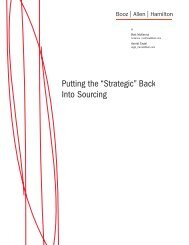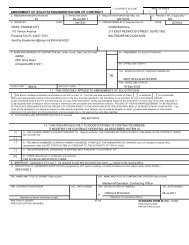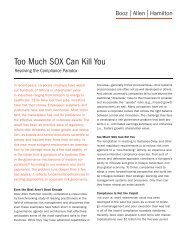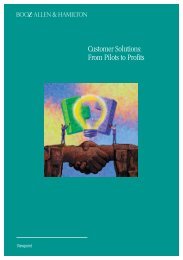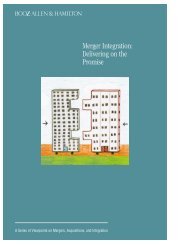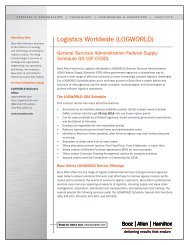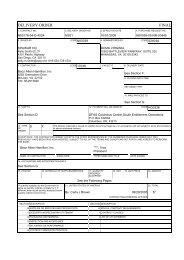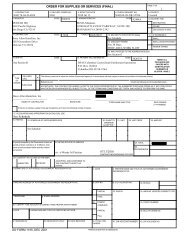Building the Enterprise - Booz Allen Hamilton
Building the Enterprise - Booz Allen Hamilton
Building the Enterprise - Booz Allen Hamilton
- No tags were found...
Create successful ePaper yourself
Turn your PDF publications into a flip-book with our unique Google optimized e-Paper software.
THE CASE FOR ENTERPRISEWhen Superstorm Sandy wreaked havoc in <strong>the</strong>mid-Atlantic region during <strong>the</strong> fall of 2012, <strong>the</strong>Federal Emergency Management Agency coordinateda massive federal response, drawing life-savingsupport services from <strong>the</strong> Department of Defense (DOD),help for utilities from <strong>the</strong> Department of Energy (DOE),housing assistance from <strong>the</strong> Department of Housing andUrban Development (HUD), medical teams from <strong>the</strong>Department of Health and Human Services (HHS) andmuch more.The response to <strong>the</strong> destructive hurricane demonstratedhow government can and must act collectivelyduring a crisis and incorporated <strong>the</strong> lessons learned frommissteps seven years earlier during Hurricane Katrina.Perhaps <strong>the</strong> most important of those lessons was <strong>the</strong>need for a comprehensive management framework tounify federal, state, local and nongovernmental disasterresponse efforts. That framework was put in place, and itproved its worth in <strong>the</strong> aftermath of Sandy.But coming toge<strong>the</strong>r as an enterprise only duringa crisis is not sufficient. Increasingly, <strong>the</strong> problems ourgovernment faces require that same sort of collective actionday in and day out. In o<strong>the</strong>r words, <strong>the</strong> remarkableinteragency collaboration we saw during Sandy mustbecome <strong>the</strong> rule ra<strong>the</strong>r than <strong>the</strong> exception. However, ittakes more than just a declaration to that effect. As welearned in <strong>the</strong> aftermath of Katrina, it takes managementrules, procedures and leadership to enable federal agenciesto work in a more unified and coordinated manner.Historically, <strong>the</strong> federal government has been structuredwith each department and agency having its ownmission. Today’s challenges rarely fit into nice, neat bureaucraticboxes. By virtue of its very structure, <strong>the</strong> federalgovernment does not often act as a single enterprisebut typically performs just <strong>the</strong> way it is organized—asseparate, largely independent agencies that do not integrateand leverage <strong>the</strong>ir resources and expertise towarda common end.Examples of such fragmentation are numerous. TheGovernment Accountability Office’s (GAO) 2013 updateof government operations that are considered to be highrisk cited <strong>the</strong> 15 agencies that have overlapping responsibilityfor administering our nation’s food safety laws. 1All have different officials in charge, different chains ofcommand, different budgets and different overseers inboth <strong>the</strong> executive and legislative branches, despite <strong>the</strong>irshared, common mission. It is a testament to <strong>the</strong>ir commitmentto that mission that it is performed so well, butimagine how much more efficiently and effectively itcould be accomplished (and how much safer our foodsupply would be) if <strong>the</strong> efforts of those 15 agencies weremore integrated and unified.The GAO also reported that HUD, <strong>the</strong> Departmentsof Commerce and Agriculture, and <strong>the</strong> Small BusinessAdministration operate 53 different economic developmentprograms for businesses in poor and disadvantagedareas. Yet <strong>the</strong>se separate training, counseling, grantand loan programs seldom work in tandem to meet <strong>the</strong>needs of entrepreneurs or taxpayers. These departmentsand agencies are attuned to <strong>the</strong>ir own missions, budgets,programs and different congressional authorization andappropriations committees even though <strong>the</strong>y all have astake in a common goal. 2Overlap and redundancy are by no means limited to1 Government Accountability Office, High Risk Series, an Update, Feb.2013, 196–201.2 Government Accountability Office, 2012 Annual Report: Opportunitiesto Reduce Duplication, Overlap and Fragmentation, Achieve Savingsand Enhance Revenue, Feb. 2012, 52–61.BUILDING THE ENTERPRISE 3





